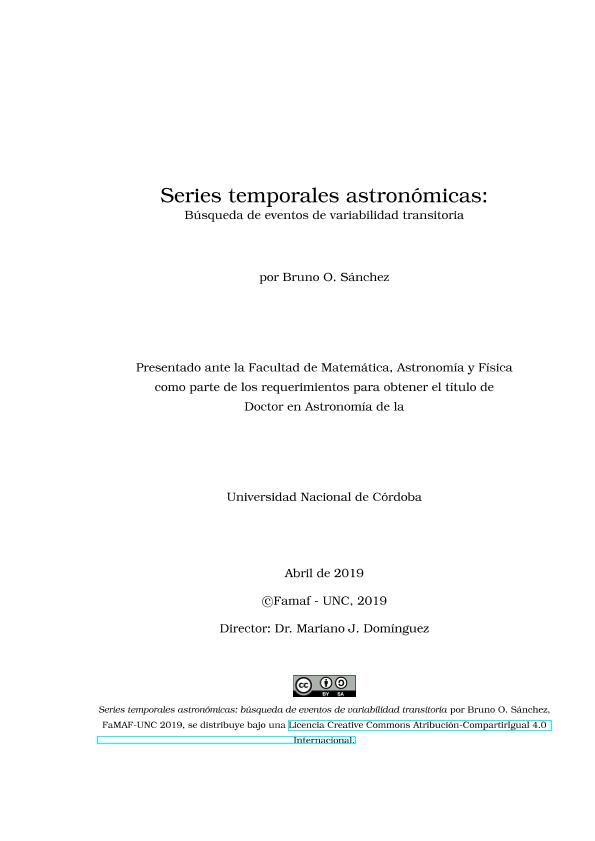Tesis doctoral
Se lleva a cabo un desarrollo de herramientas para el análisis de imágenes astronómicas. Entre éstas se encuentran herramientas de base de datos, de reducción y calibración de datos, herramientas de comparación directa entre imágenes o sustracción de imágenes, clasificación de eventos detectados y finalmente clasificación de curvas de luz de estrellas variables. La metodología desarrollada se enmarca dentro de un proyecto observacional en sinergia con el observatorio de ondas gravitacionales LIGO: Laser Interferometer Gravitational Observatory. Dentro de las técnicas aplicadas podemos mencionar análisis estadı́sticos de señales en imágenes de telescopios, y señales en series temporales; algoritmos de clasificación mediante aprendizaje automático, y redes neuronales artificiales. Durante el doctorado se analizaron imágenes tomadas para la búsqueda de contrapartes electromagnéticas a cuatro eventos de ondas gravitacionales observados por el observatorio LIGO. Entre ellos el caso de la primera detección en la historia de radiación gravitacional, y la detección de la primer fusión de estrellas de neutrones y su emisión electromagnética, o Kilonova. Por ultimo se realiza un análisis de la efectividad en la clasificación de curvas de luz de estrellas variables periódicas, utilizando un grupo de curvas de luz provenientes de la base de datos del relevamiento ATLAS (Asteroid Terrestrial-impact Last Alert System), cuyo catálogo de objetos candidatos a variables contiene cerca de 5 millones de objetos. This PhD. thesis presents research related to the search and detection of of transient variability events of the brightness of celestial bodies. The developement of a set of tools for astronomical image analysis is carried out. Among them we list database tools, image data reduction and calibration direct comparison between image tools or difference image analysis tools, detection classification, and finally light curve classification of variable stars. The methodology developed lays on a background of special circumnstances, inside a proyect in synergy with the gravitational wave observatory LIGO or Laser Interferometer Gravitational Observatory. Among the applied techniques we may find statistical analysis of signals in telescope image data, time series signal analysis, classification machine learning algorithms, and artificial neuronal networks. During the PhD. a series of images were analyzed, taken for the electromagnetic counterpart search, related to the four observed gravitational wave events by LIGO observatory. In this follow up observations are included the first ever detection of gravitational radiation, and the first ever detected neutron star merger event together with its electromagnetic emission called Kilonova. Lastly an analysis of performance on light curve classification of periodic variable stars, using a set of light curves from the ATLAS (Asteroid Terrestrial-impact Last Alert System) database, which holds near 5 milllion of variable object candidates.
Series temporales astronómicas: Búsqueda de eventos de variabilidad transitoria
Sánchez, Bruno Orlando

Director:
Dominguez Romero, Mariano Javier de Leon

Codirector:
Lares Harbin Latorre, Marcelo

Fecha de publicación:
05/04/2019
Idioma:
Español
Clasificación temática:
Resumen
Palabras clave:
ASTRONOMIA
,
TRANSITORIOS
,
GALAXIAS
Archivos asociados
Licencia
Identificadores
Colecciones
Tesis(CIFASIS)
Tesis de CENTRO INT.FRANCO ARG.D/CS D/L/INF.Y SISTEM.
Tesis de CENTRO INT.FRANCO ARG.D/CS D/L/INF.Y SISTEM.
Citación
Sánchez, Bruno Orlando; Dominguez Romero, Mariano Javier de Leon; Lares Harbin Latorre, Marcelo; Series temporales astronómicas: Búsqueda de eventos de variabilidad transitoria; 5-4-2019
Compartir



